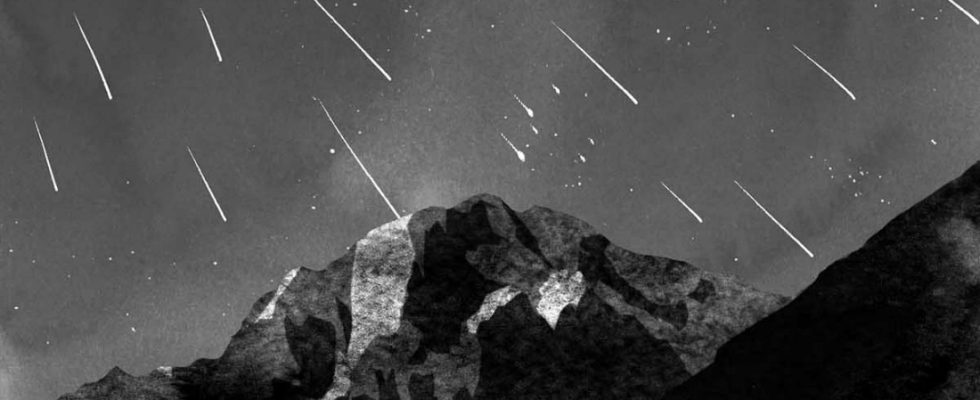One should not deceive oneself: because, contrary to what one might think, nothing escapes the people in the remoteness of the high mountains. Especially not there: on the Jungfraujoch, for example, aerosol measurements are carried out regularly, from which conclusions can be drawn as to the extent to which individual European countries are adhering to the agreements of the Paris climate protection agreement. In relation to this aspect, you can see large parts of the continent from the Jungfraujoch.
Blandine Pluchet is fascinated by such stories. She graduated with a degree in physics more than twenty years ago, and if her original plan had worked, she might now also be a researcher working in and with the mountains. However, her application for a doctoral position at the Institute for Meteorology and Climate Research in Garmisch-Partenkirchen was rejected at the time. Pluchet then became a writer.
Physicist Hannes Vogelmann uses a laser to conduct research in the atmosphere on the Zugspitze.
(Photo: Laëtitia Locteau (Illustration)/Flammarion, Paris)
However: “Physics stayed, it provided the material for my books,” writes Pluchet in the foreword of her book “Measuring the Mountains”. This is especially true for this title. The research for this, triggered by a climbing tour in the Bavarian Alps together with a good friend, brought her back into contact with the mountains. “I wanted to learn a lot more about the mountains. I had to get to know these mountains better, which whispered their history in my ear. No longer as a hiker, but as a physicist.” For a year she kept meeting scientists, mostly in the Alps, but also in the Pyrenees, Apennines, Massif Central and Harz mountains, as well as in her native western France. The first path led the author to Garmisch-Partenkirchen, to the institute that she did not want to join at the time.
Here she meets Hannes Vogelmann, who conducts atmospheric research on the Zugspitze with the help of a laser beam. This is very practical physics, which Pluchet is also fond of: She is interested in a science, she writes, “that looks at the world, that looks at the wind, the earth or the sky, a physics that explores the outside”. A physics that exposes itself to the elements.
The mountains serve as an early warning system for climate changes
Your book “Measuring the Mountains” is not a scientific work, and as a reader you don’t need to have any expertise, just curiosity and openness. Then you can go on extraordinary hikes with Blandine Pluchet and look at the mountains from a very special, very enlightening point of view.
In some cases, the mountains are suitable for research that is not related to the mountains themselves. Far away from civilization and therefore free from disturbing influences that falsify the measurement results, insights can be gained there, for example about environmental pollution and climate changes. In this respect, the mountains serve as an early warning system. In other cases, however, a mountain range itself can be better understood with the help of physics. And then there are a number of fascinating phenomena that one can find oneself exposed to in the high mountains – and for which there is always a physical explanation.
Mountains are decisive for the weather.
(Photo: Laëtitia Locteau (Illustration)/Flammarion, Paris)
Blandine Pluchet talks to Hannes Vogelmann about St. Elmo’s Fire, halos and sylphs – all light phenomena that are related to electrical charges in the air. And they talk about the chunk ghost, an optical phenomenon that has become the subject of sagas and legends. However, for which there is also a scientific explanation: The chunk specter is nothing other than the extended shadow of the one who sees this supposed specter. Depending on the position of the sun and the height of the fog banks or clouds, this phenomenon can occur, not only on the Brocken, but particularly frequently there due to the conditions.
What is appealing about “Measuring the Mountains” is that Blandine Pluchet does not proceed in a cool dissecting manner. She’s not interested in a disenchantment. The urge to understand certain phenomena and connections only increases their enthusiasm and curiosity. For example, there are explanations as to why you can see the depth of space more clearly in the high mountains and why “the three-dimensionality of the landscape emerges more clearly than anywhere else” – this is due to the great distances and the fact that the air there contains much less moisture and dust. However, this knowledge in no way reduces the fascination that this visual impression arouses.
Blandine Pluchet: Surveying the mountains. A hike to discover the laws of the world. Translated from the French by Reiner Pfleiderer. Bergwelten Verlag, Salzburg/Munich 2023. 216 pages, 28 euros.
(Photo: Bergwelten Verlag)
The author retains her ability to marvel, she allows herself to be touched and seduced by the alpine landscape, she searches for moments of overpowering. And then to get to the bottom of things again and again. For example, based on the occurrence of a certain flower – the Bohemian yellow star – which only grows where two geological zones meet, namely granite and limestone, she manages to deduce that there is a mountain range in north-western France, albeit never in any relevant way extent has been unfolded.
The development of knowledge means that one is only all the more fascinated the more connections one recognizes or is explained. On your own, you would simply not (be able to) perceive many things. Incidentally, Blandine Pluchet finds out again and again that those who make their observations in the dark learn and experience a great deal.

